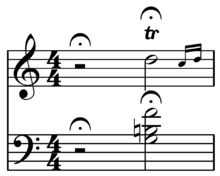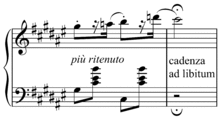카덴차
보이기

 Play (도움말·정보)
Play (도움말·정보)
 Play (도움말·정보) The I6
Play (도움말·정보) The I64–V–I progression at the cadenza is typical of the Classical concerto.[2]


 Play (도움말·정보)
Play (도움말·정보)
 Play pause (도움말·정보) or
Play pause (도움말·정보) or  Play written out (도움말·정보) cadenza
Play written out (도움말·정보) cadenza음악에서, 카덴차는 리듬을 의미하는 "cadenza"를 부른다;복수, cadenzite, 또는 자유롭게 즉흥적으로 연주한다. 이 시간 동안 반주는 쉬거나 음이나 화음이 지속된다. 따라서 즉흥적으로 만들어진 카덴자는 모든 부분에서 늘임표에 의해 쓰여진 표기법으로 나타난다. 일반적으로, 카덴차는 한조각의 최종 또는 주기 노트 또는 중요한 부분의 최종 또는 주기 노트에서 발생한다. 그것은 또한 마지막 코다나 리토르넬로 전에 발견될 수 있다.
각주
[편집]- ↑ Sir George Grove (1904). Grove's Dictionary of Music and Musicians, Vol. 1, p.442. John Alexander Fuller-Maitland, ed. Macmillan Company.
- ↑ 가 나 Randel, Don Michael (2003). The Harvard Dictionary of Music, p.132. ISBN 978-0-674-01163-2.
- ↑ Kinderman, William (2006). Mozart's Piano Music, Ex.4.2. Oxford University Press. ISBN 9780199880164.
- ↑ Kostka, Stefan and Payne, Dorothy (1995). Tonal Harmony, p.143. ISBN 0073000566.
